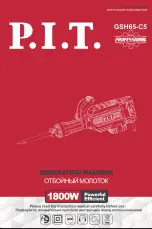
4
Using the Control Switch
The control switch may be set to three positions:
forward, reverse and lock. Always allow the motor
to come to a complete stop before using the control
switch to avoid damage to the tool.
For
forward
(clockwise) rotation, push in the control
switch from the right side of the tool. Check the direc
-
tion of rotation before use.
For
reverse
(counterclockwise) rotation, push in the
control switch from the left side of the tool. Check
direction of rotation before use.
To
lock
the trigger, push the control switch to the
center position. The trigger will not work while the
control switch is in the center locked position. Always
lock the trigger or remove the battery pack before
performing maintenance, changing accessories,
storing the tool and any time the tool is not in use.
Starting, Stopping and Controlling Speed
1. To
start
the tool, grasp the handle firmly and pull
the trigger.
NOTE:
An LED is turned on when the trigger is
pulled.
2. To
vary
the speed, increase or decrease the pres-
sure on the trigger. The further the trigger is pulled,
the greater the speed.
3. To
stop
the tool, release the trigger. Make sure
the tool comes to a complete stop before laying
the tool down.
Operating
Position the tool, grasp the handle firmly and pull
the trigger. Always hold the tool securely to maintain
control. This tool has been designed to achieve top
performance with only moderate pressure. Let the
tool do the work.
If the speed begins to drop off when drilling large or
deep holes, pull the bit partially out of the hole while
the tool is running to help clear dust. Do not use water
to settle the dust since it will clog the bit flutes and
tend to make the bit bind in the hole. If the bit should
bind, stop the tool, free the bit and begin again.
APPLICATIONS
WARNING
To reduce the risk of electric shock,
check work area for hidden pipes
and wires before drilling or driving screws.
Selecting Bits
When selecting a bit, use the right type for your job.
For best performance, always use sharp bits.
Drilling
1. Before drilling, be sure the workpiece is clamped
securely. Use backing material to prevent damage
to the workpiece during breakthrough.
2. When starting a hole, place the drill bit on the work
surface and apply firm pressure. Begin drilling at
a slow speed, gradually increasing the speed as
you drill.
3. Always apply pressure in line with the bit. Use
enough pressure to keep the drill biting, but do
not push hard enough to stall the motor.
4. Reduce pressure and ease the bit through the last
part of the hole. While the tool is still running, pull
the bit out of the hole to prevent jamming.
Drilling in Wood, Composition Materials
and Plastic
(Use chuck adapter kit Cat. No. 48-66-1370)
When drilling in wood, composition materials and
plastic, start the drill slowly, gradually increasing
WARNING
Only use accessories specifically
recommended for this tool. Others
may be hazardous.
To reduce the risk of injury, always use a side
handle when using this tool. Always brace or
hold securely.
Adjusting the Side Handle Position
1. Loosen the side handle by unscrewing the side
handle grip until the side handle rotates freely.
2. Rotate the side handle to the desired position.
3. Tighten the side handle grip securely.
Setting the Depth Gauge
1. Press in the clamping lever.
2. Slide the depth gauge rod backward or forward
until it is set for the desired depth.
NOTE:
The drilling depth is the distance between
the tip of the bit and the tip of the depth gauge rod.
3. Release the clamping lever.
Installing Bits
NOTE:
Only use accessories with SDS or SDS Plus
shanks.
Be sure that the shank of the bit is clean. Dirt particles
may cause the bit to line up improperly. Do not use
bits larger than the maximum recommended capacity
of the drill because gear damage or motor overload-
ing may result. For best performance, be sure that
the bit is properly sharpened and the shank is lightly
greased before use.
1. Insert the bit into the nose of the tool.
2. Rotate bit slowly until it aligns with the locking
mechanism.
3. Push bit into tool until it locks.
4. Check that the bit is locked properly; it should be
possible to pull the bit back and forth slightly (about
1/4”).
5. To remove bits, pull bit holder release collar toward
the rear of tool and remove bit.
NOTE:
Use caution when handling hot bits.
OPERATION
WARNING
Always remove battery pack before
changing or removing accesso-
ries. Only use accessories specifically recom
-
mended for this tool. Others may be hazardous.
To reduce the risk of injury, keep hands away
from the bit and all moving parts. Always wear
safety goggles or glasses with side shields.
To reduce the risk of injury, wear a dust mask or
use an OSHA compliant dust extraction solution
when working in dusty situations.
To reduce the risk of injury, always use a side
handle when using this tool. Always brace or
hold securely.
Selecting Action
Always allow the motor to come to a complete stop
before changing the mode selection to avoid dam-
age to the tool.
1. For drilling, turn the mode selector
so the arrow points to the twist
drill
symbol.
2. For rotary hammering, turn the
mode selector so the arrow
points to the hammer and twist
drill
symbol.
NOTE:
To engage the hammering mechanism, main-
tain pressure on the bit. When pressure on the bit is
released, the hammering action will stop.


























